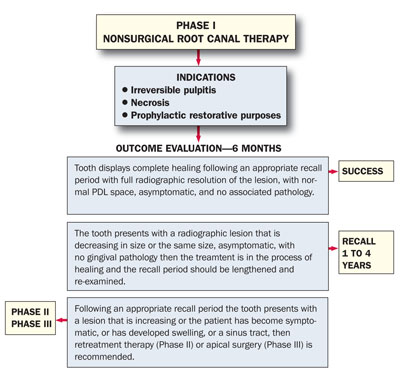Home › Forums › Endodontics & conservative dentistry › Phase Format Treatment for Endodontic Therapy
Welcome Dear Guest
To create a new topic please register on the forums. For help contact : discussdentistry@hotmail.com
- This topic has 0 replies, 1 voice, and was last updated 13/04/2012 at 5:22 pm by
Anonymous.
-
AuthorPosts
-
13/04/2012 at 5:22 pm #10448
Anonymous
OnlineTopics: 0Replies: 1150Has thanked: 0 timesBeen thanked: 1 timePhase Format Treatment for Endodontic Therapy

Figure 1. Phase I: Nonsurgical root canal therapy outcome assessment flow chart. INTRODUCTION
Current trends in endodontic therapy aim to more adequately disinfect the root canal system. The introduction of nickel titanium rotary instruments has allowed a more efficient debridement of the canal and expel pathogenic debris coronally rather than apically.1,2Activated irrigation regimens of 5.25% NaOCl, 17% EDTA, and 2% chlorhexadine have also been shown to penetrate biofilms and inaccessible areas of the root canal system to achieve disinfection.3-6 Additionally, magnified visualization with microscopes has allowed detection and differentiation of previously unobserved morphology. Current microsurgical endodontic procedures with ultrasonic preparation and biocompatible retrofillings have also significantly improved treatment outcomes compared to traditional techniques.7-10 These advancements have allowed the modern trend of evaluating early endodontic treatment success at 6 months to one year.11-13 However, retrospective evaluation of more modern techniques have shown that a longer recall period may allow continued healing, and that late periapical changes in endodontically treated roots resulted in more successes than failures. Even with this current knowledge, the criteria used to evaluate endodontic treatment success and failure dates back to the 1950s and 1960s. In 1956, Strindberg developed strict radiographic criteria in which the contours and width of the periodontal ligament were normal or widened around excess filling material and a failure was a decrease, no change, or increase in the periradicular rarefaction. Bender18 went on to publish a reappraisal of endodontic success criteria in 1965 that highlighted the pitfalls of radiographic interpretation, recall period, pathology and patient and provider subjectivity. Seltzer19,20 built upon this in 1967 and concluded that since there is no agreement of a definition of success, then regardless of radiographic interpretation, endodontically treated teeth which are functioning adequately without adverse clinical symptoms should be regarded as successfully treated. Nonetheless, the criteria used to evaluate modern endodontic treatment needs to reflect current trends.
The purpose of this paper is to introduce a phase format treatment outcome assessment guideline that incorporates current knowledge of endodontic therapy success.PHASE FORMAT ENDODONTIC THERAPY
Endodontic therapy consists of and progresses from initial root canal therapy, root canal retreatment, and apical surgery. The phase format will provide an outline for clinicians to exhaust all treatment options prior to determining the tooth inoperable. The field of periodontics introduced this concept of presenting a phase format treatment plan as an entire unit in which Phase I is nonsurgical, Phase II is surgical, Phase III is restorative, and Phase IV is maintenance.21
The field of endodontics needs to expand upon this design and present treatment as an entire unit. By presenting endodontic procedures as an overall therapy to achieve success, it becomes apparent that each phase of the treatment is completed to provide a foundation for rehabilitation. Each stage of treatment will be evaluated independently, but the assessment of treatment failure should not be concluded prior to progressing through the phases of therapy. Endodontic therapy is intended to achieve results within the confines of the treatment provided in the same fashion that retreatment therapy and apical surgery are evaluated within the parameters of their outcome expectations. -
AuthorPosts
- You must be logged in to reply to this topic.